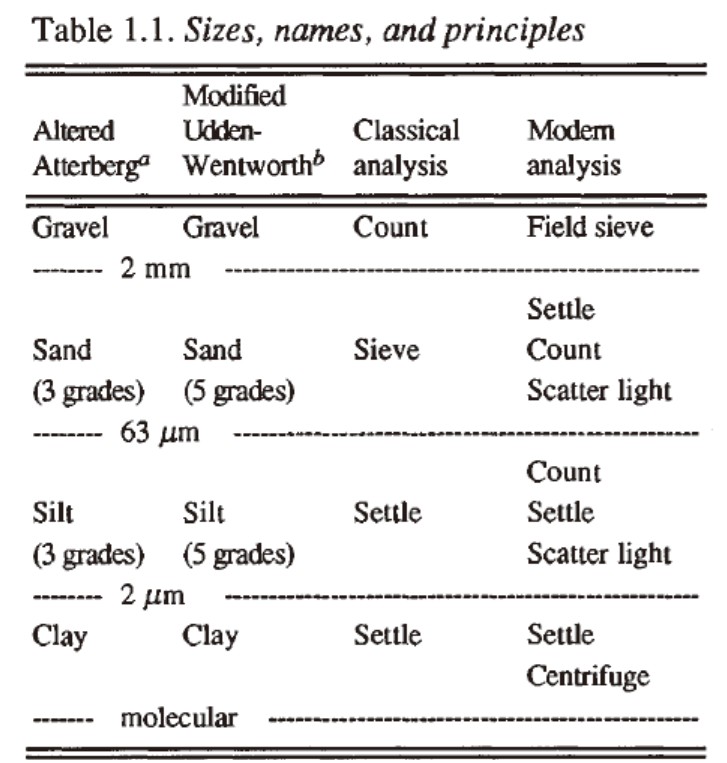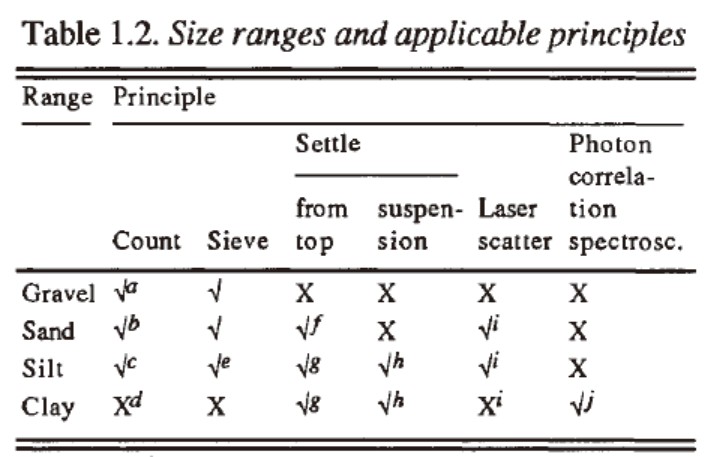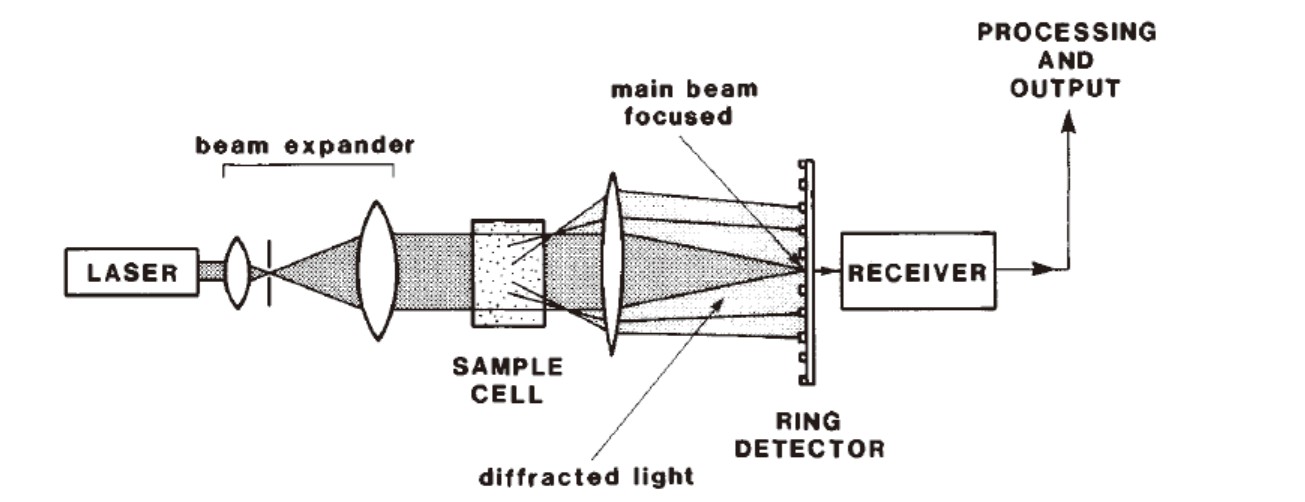
Tech Articles
Particle size is a fundamental property of sedimentary materials that may tell us much about their origins and history. In particular the dynamical conditions of transport and deposition of the constituent particles of rocks is usually inferred from their size. The size distribution is also an essential property for assessing the likely behaviour of granular material under applied fluid or gravitational forces, and gauging the economic utility of bulk materials ranging from foundry sands to china clay.
Among solid bodies only a sphere has a single characteristic linear dimension. Irregular sedimentary particles possess many properties from which several characteristic linear dimensions may be obtained. These include a particle's projected area, settling velocity, volume, lengths, and the size of a hole through which it will pass. These dimensions are, of course, not equivalent, save in special circumstances (e.g., for a sphere), a fact which is generally appreciated but usually overlooked. Krumbein & Pettijohn (1938) give a detailed analysis of the properties used as measures of particle size. Their book is the reference for all that we shall refer to as "classical" in this chapter. There is a huge variety of commercially available instruments, but we have not attempted to list them all.
At the outset one must remember that we do deal with samples and determine sample, not population, properties. The strictures bearing on the statistical inferences that may be drawn from samples are lucidly set out by Griffiths and will not be rehearsed here.
Geological materials commonly contain a wide range of particle sizes from tens of millimetres down to clay of colloidal (<1 um) size. Both the wide range and the fact that there is no lower size cutoff present analytical problems. The chemical industry also requires size analysis of powders and other materials (Barth, 1984). These are usually intended to contain a well
characterized, usually narrow size (and shape) range with little material in the colloidal range, not wide spectrum size distributions. Many of the modern instruments currently being adapted for geological use were designed with these narrow-spectrum analytical requirements in mind (e.g., the Coulter Counter for blood cells, the laser particle sizer for fuel spray droplet size).
Geologists should note that these instruments do not sense the whole clay range. It is as though they give a detailed description of the size of tails without saying whether they are attached to elephants or fish!
Under special circumstances we encounter materials that are well sorted (i.e., their grain size distributions have low standard deviations) and unimodal - for example, dune sands, gravels in some fluvial bars, and loess. However, many samples, even when moderately well sorted, are polymodal, and methods of analysis need to be able to resolve modal structure.
The degree of lithification of geological materials is very variable, but much apparently indurated material can be disaggregated by prolonged agitation together with some ultrasonic treatment. Rock that cannot be disaggregated can be analyzed only by measurement and counting in thin section for sand and silt, or equivalent outcrop methods for conglomerates. Only with
complex back-calculations involving particle size, shape, and density values, can thin-section data be used for an understanding of the hydraulic properties of geological samples. Because of the small area of thin sections, the small sample volume of poorly sorted samples means that the coarser end of the size spectrum is underrepresented. Even if a sample may be disaggregated, this does not guarantee unaltered material. The fine fraction may have suffered diagenetic change, carbonate sand grains may have been removed in solution, and other grains may have overgrowths.
The most familiar samples are those obtained from deposits, whether rock or modern sediment. Material in transit can also be sampled, and this may either yield a flux-related sample (e.g., from a sediment trap at sea or an aeolian saltation trap) or simply a sample of the content of a given volume of water in the sea or a river obtained by filtration. Such samples are
typically rather small, but modern methods are particularly good at dealing with them.
There is an important difference between flux samples and inventory samples because the former contain the dimension of time (dimensions ML-2 T-1) whereas the latter do not (dimensions ML-3). Geological deposits are clearly flux related, but our ability to know the time value involved with a thin layer of sediment is usually rather poor. In varved sediments, analyses
of size can be converted into annual fluxes of different grades of material, whereas analyses of a bulk sample from a debris flow cannot.
Finally we may distinguish material whose size is sufficiently controlled by the dynamics of the depositional process that analysis of size allows some inference of the nature and intensity of that process (e.g., see Middleton [1976] for inference of fluvial shear velocities from size distributions) from those where the process of transport and deposition does not have much
affect on the size distribution (e.g., ice rafting or debris flow), though it may well yield a characteristic fabric.
Field versus laboratory techniques
Most size analysis is carried out in the laboratory. Approximate estimation using a grain size comparator is commonly undertaken for sand sizes in the field, but any instrumental work is laboratory based. The exception is measurement of the size of gravels and conglomerates. For coarse stream gravels it is usually impracticable to transport sufficiently large samples back to the lab. Large-diameter steel plate sieves are used in the field with a simple weighing balance (e.g., kitchen scales). For conglomerates a net strewn over the outcrop is used to select the grains for measurement by ruler and point counting of grains and matrix.
Boundaries and methods
There are three principal categories of material in terms of mode of transport. Gravel is nearly always bedload and mud is nearly always carried in suspension, whereas sand may be either. Mud is further divided into silt and clay, a distinction of mineralogical but not dynamical significance. There are, of course, exceptions to this, in that gravel may be carried in suspension in very fast flows such as turbidity currents or giant floods, and a small amount of silt is carried as bedload, saltating in the viscous sublayer of the turbulent boundary layer. The boundaries between these grades are arbitrary but most branches of science - engineering, soil science, clay mineralogy, sedimentology-agree on them to within a factor of two. We believe the most useful schemes to be modifications of the Udden-Wentworth and Atterberg boundaries as shown in Table 1.1.

Table 1.1 Sizes, names and principles
Classical versus modern techniques
The classical techniques of particle counting, sieving, and settling are still in use though often using automated instruments. New ways of sensing old variables, such as discriminating and counting grains by image analyzers, have also been developed. In addition there are some completely new principles in use - laser diffraction and photon correlation spectroscopy. Table
1.2 sets out the principles and size ranges to which they are applicable with brief notes on methods and instruments. Subsequent sections of this chapter, as well as other chapters in this book, will examine these in depth. An overview is provided here, highlighting recent advances.

Table 1.2 Size ranges and applicable principles
Counting
Modern counting of particles uses either image analyzers or several varieties of particle counter. Images are obtained traditionally with transmitted light microscopy or, for smaller particles, via scanning electron microscopy. Images of suspended particles in situ may be obtained from plankton or marine snow cameras (Honjo et al., 1984; Netherlands Institute for Sea Research,
1989; Syvitski et al., 1989). In ordinary light microscopy and SEM work the image analysis system may operate directly on images without the intermediary of photographs. Image analyzers are designed to sense the boundaries of particles, usually through highly sensitive gray levels (64-120 in number). Once the outlines of all the particles are discriminated, the particle size and shape parameters may be obtained either through line scanning, pixel counting, or outline tracing. These parameters may include minimum or maximum grain diameters, or the circular area-equivalent diameter. In the case of thin-section data, these particle diameter distributions must be corrected for sectioning bias.
Instrumental methods of particle counting are dominated by the electrical sensing zone particle counters, of which the best known makes are from Coulter and Elzone. Light-blockage counters are less widely used but cover a similar range, mainly silt but straying a little way into sand and down into clay in ordinary usage.
Sieving
There is no new principle in sieving, but automated systems for wet sieving, sonic, electromagnetic, and air-jet particle agitation have been added to the standard mechanical dry sieve shaking method. Electroformed sieves are now available that take the range of analysis below the 31um permitted by woven-wire sieves. This has extended the range down to 5um, but not
for routine analysis. This chapter will not deal further with sieving as the principles are well covered in older texts (Krumbein & Pettijohn, 1938; Carver, 1971; Folk, 1974); the manufacturers of modern sieves and sieve shakers are given by Stanley-Wood.
Settling of suspensions
In sedimentation analysis one must distinguish between the settling of a well-mixed homogeneous dispersion and that of particles introduced at the top of a column. The only significant new departure in this area is the use of x-ray attenuation to sense the time-varying density of a settling suspension; otherwise all the methods are at least thirty years old. There are some new tricks in centrifugal sedimentation in which the basic sedimentation method can be extended down well into the clay range. One such novel idea is to analyze fine-grained suspensions introduced at the top of a clear column. Normally, if this were done simply in water overlain by clay suspension, the clay suspension would sink in plumes rather than as single particles. This has been overcome in the Joyce-Loebl disk centrifuge by introducing the particles via a density gradient.
Laser diffraction
Methods based on the scattering of light by suspensions began to be implemented in the late 1970s. There are many suppliers globally.

Photon correlation spectroscopy
There are very few techniques that will yield data well into the submicron range. Photon correlation spectroscopy, which depends on the Brownian motion of suspended colloidal particles, is one. The method is not appropriate for larger particles, so there could be problems of data overlap.
All Rights Reserved by Gold APP Instruments Corp. Ltd.
WeChat WhatsApp


GOLD APP INSTRUMENTS CORP. LTD.
HongKong Add: Flat Rm A17, Legend Tower, No. 7 Shing Yip Street, HK, China
Mainland Add: R1302, Baoli Tianyue, Shaowen Rd., Yanta Dist., Xi'an 710077, China
T: +86-182 0108 5158
E: sales@goldapp.com.cn